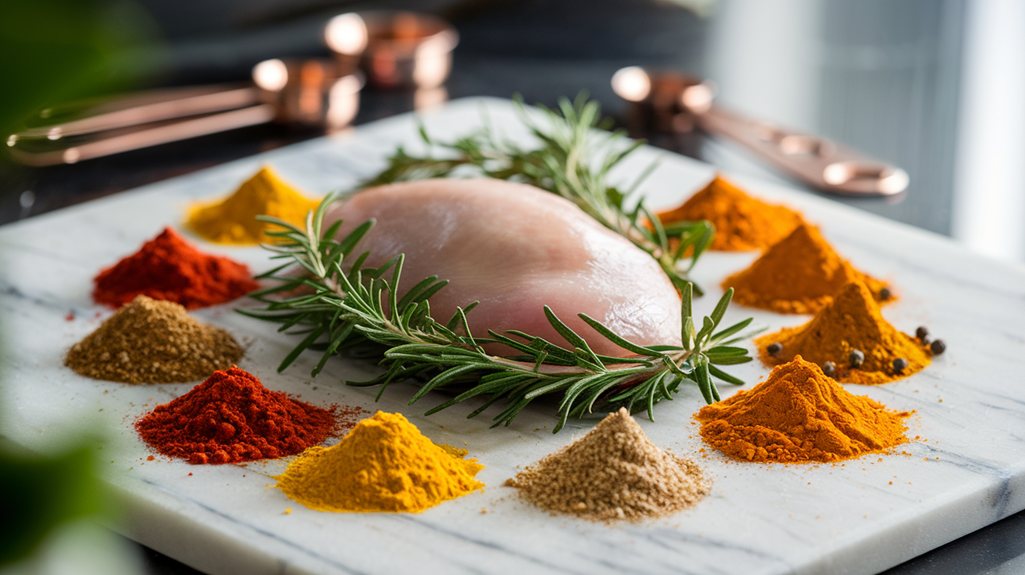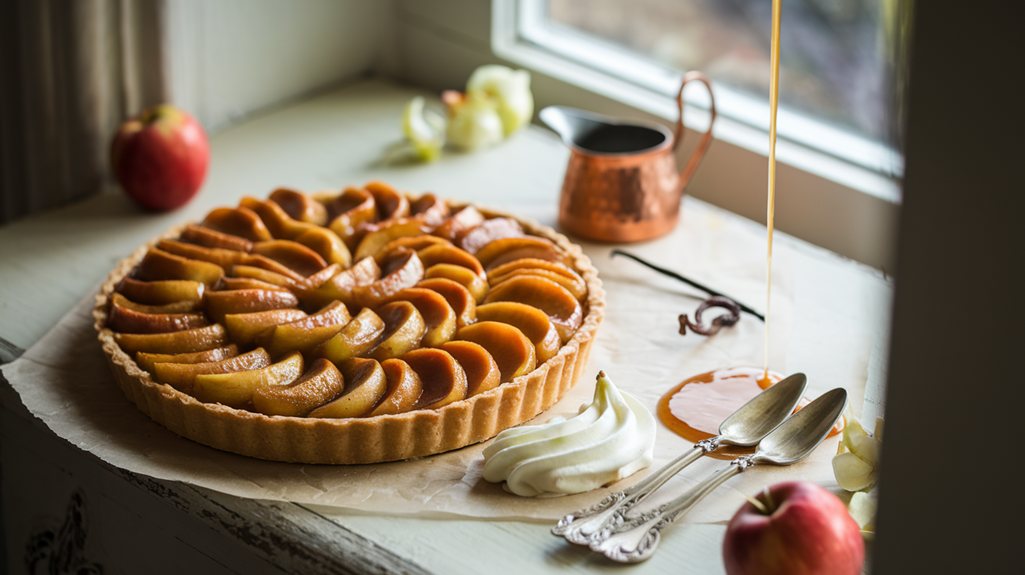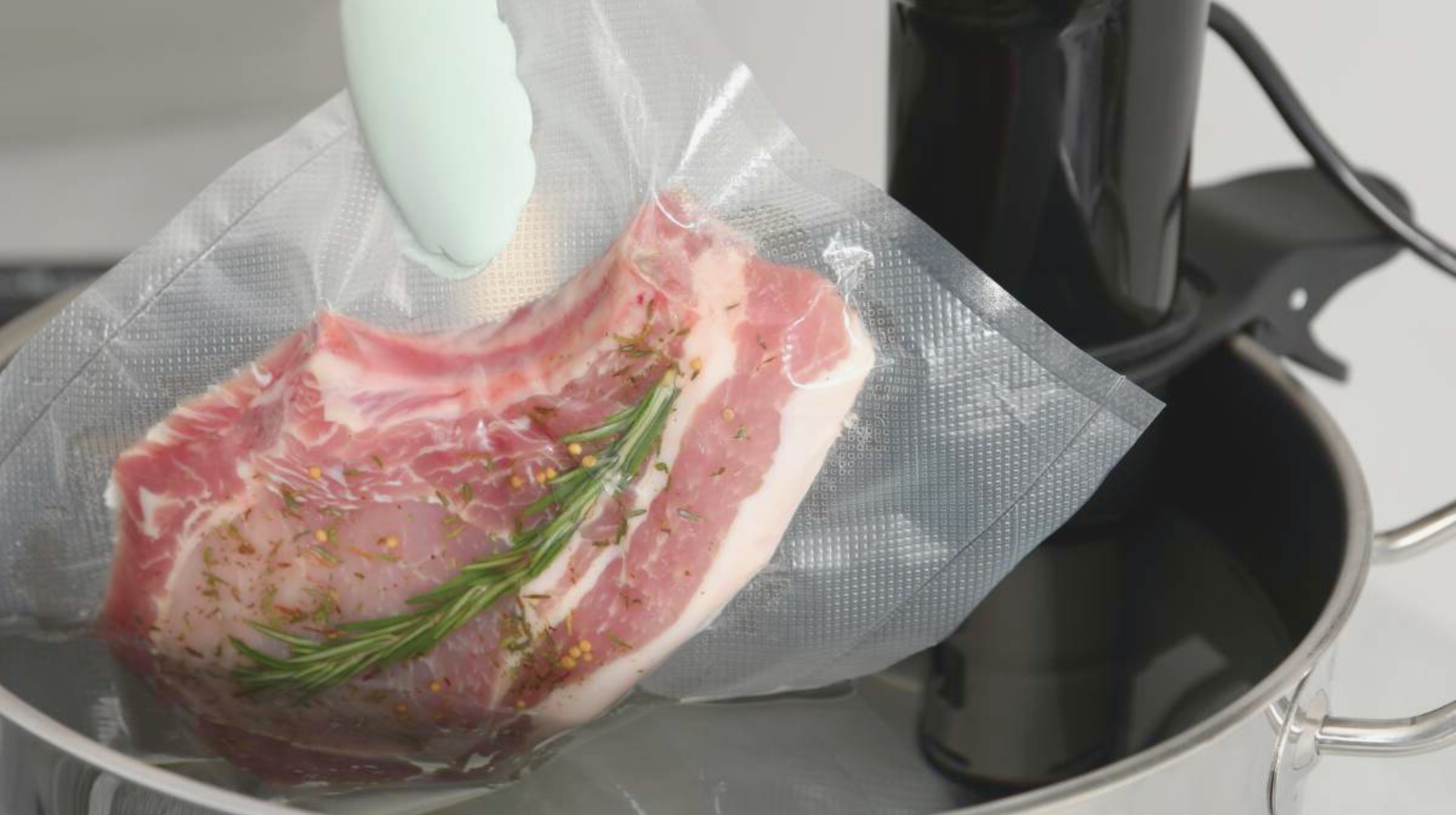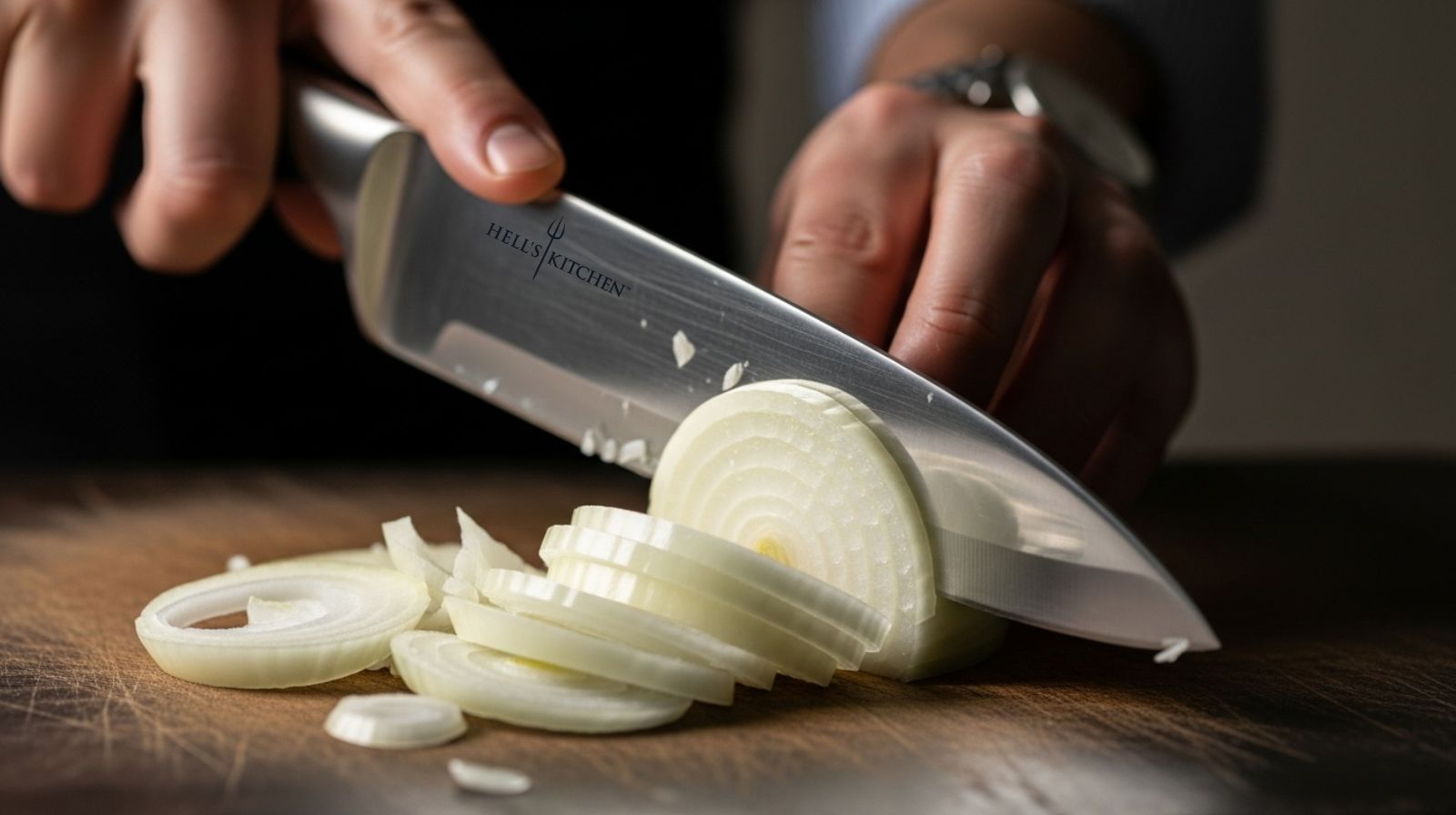Mastering chicken seasoning starts with a foundational blend of kosher salt, black pepper, and garlic powder, using one tablespoon of seasoning per pound of meat. A proper dry-brine with salt for 30 minutes allows flavors to penetrate while retaining moisture. Classic combinations like Mediterranean, Southwest, and Asian fusion provide versatile starting points for customization. Strategic layering of spices, from base seasonings to finishing herbs, transforms ordinary poultry into exceptional dishes. These crucial techniques reveal countless flavor possibilities.
Key Notes
- Use one tablespoon of seasoning per pound of chicken, starting with salt to ensure proper moisture retention and flavor.
- Pat chicken dry before seasoning and allow it to rest for 30 minutes at room temperature after applying spices.
- Master the holy trinity of chicken seasoning: kosher salt, black pepper, and garlic powder for a solid flavor foundation.
- Explore classic combinations like Mediterranean, Southwest, or Asian fusion blends for diverse and proven flavor profiles.
- Layer seasonings systematically: base spices first, followed by aromatics, and finish with heat elements or fresh herbs.
Why Seasoning Makes Chicken Shine
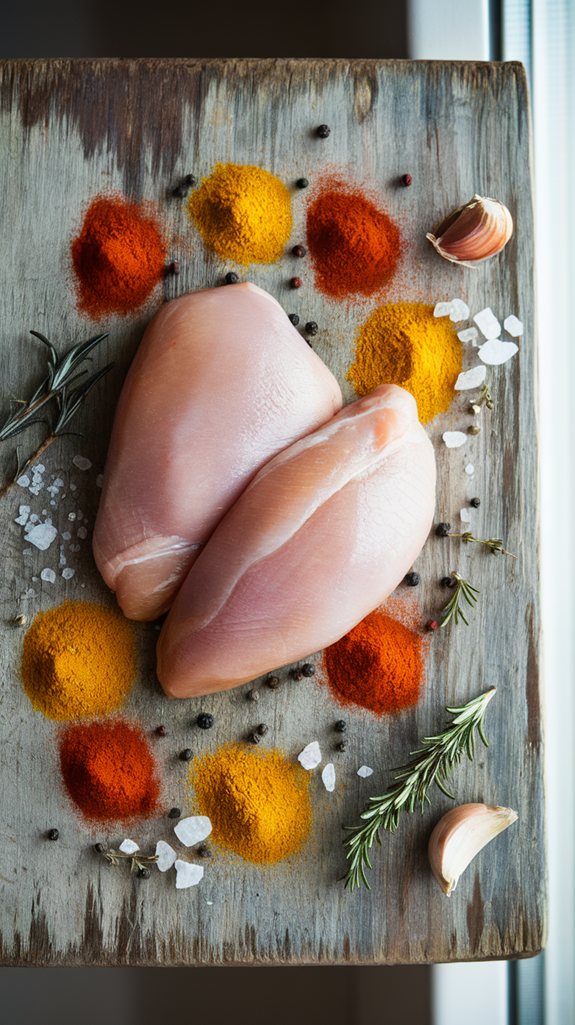
Seasoning chicken is essential for transforming this versatile protein into a delectable centerpiece for any meal. The magic happens when salt penetrates the meat fibers, helping chicken retain moisture while enhancing its natural flavors.
Crucial seasonings work together, with salt tenderizing the protein structure and pepper adding depth.
A strategic combination of herbs, spices, and acids creates layers of flavor that raise simple chicken into something extraordinary. One tablespoon of seasoning per pound of meat guarantees balanced taste, while marination times of 30 minutes to 24 hours allow flavors to fully develop. Just as with proper steak seasoning, salt and pepper form the foundation for bringing out the meat's natural flavors.
Essential Spices and Herbs for Perfect Chicken
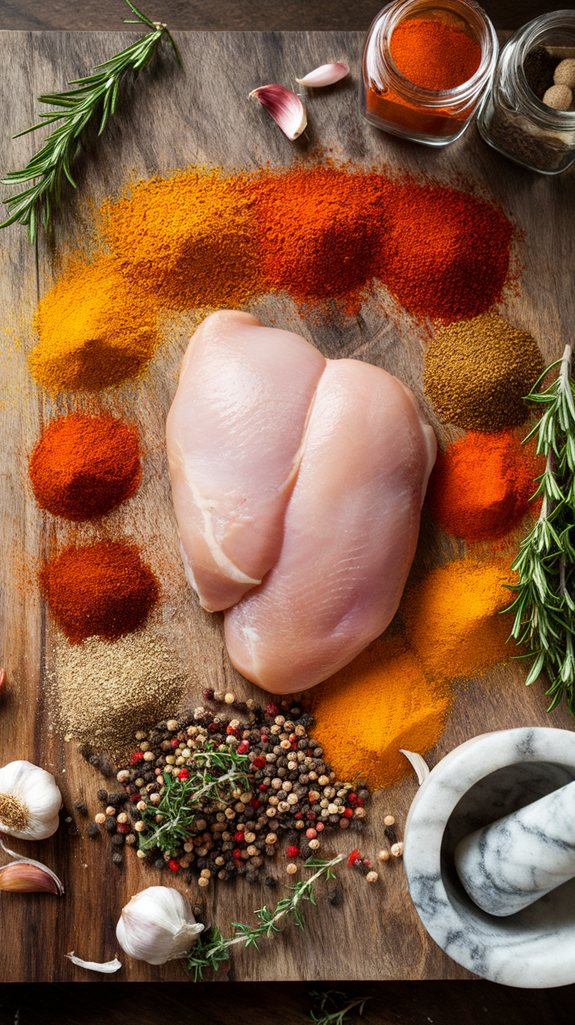
Spices and herbs for chicken is a core collection of versatile seasonings that every home cook should keep stocked.
Basic pantry necessities transform bland poultry into mouthwatering meals through strategic combinations and proper ratios.
With the right pantry staples and seasoning know-how, even the plainest chicken becomes an irresistible masterpiece worth savoring.
- Start with the holy trinity: kosher salt (1 tablespoon per pound), fresh-cracked black pepper (1 teaspoon per pound), and garlic powder (2 teaspoons per pound)
- Layer in aromatics: dried thyme, rosemary, and oregano (1 teaspoon each)
- Add depth with smoked paprika (1 tablespoon), onion powder (2 teaspoons), and cayenne (¼ teaspoon for subtle heat)
For an authentic Caribbean flavor profile, incorporate Scotch bonnet peppers and allspice into your seasoning blend.
Step-by-Step Guide to Seasoning Chicken Like a Pro
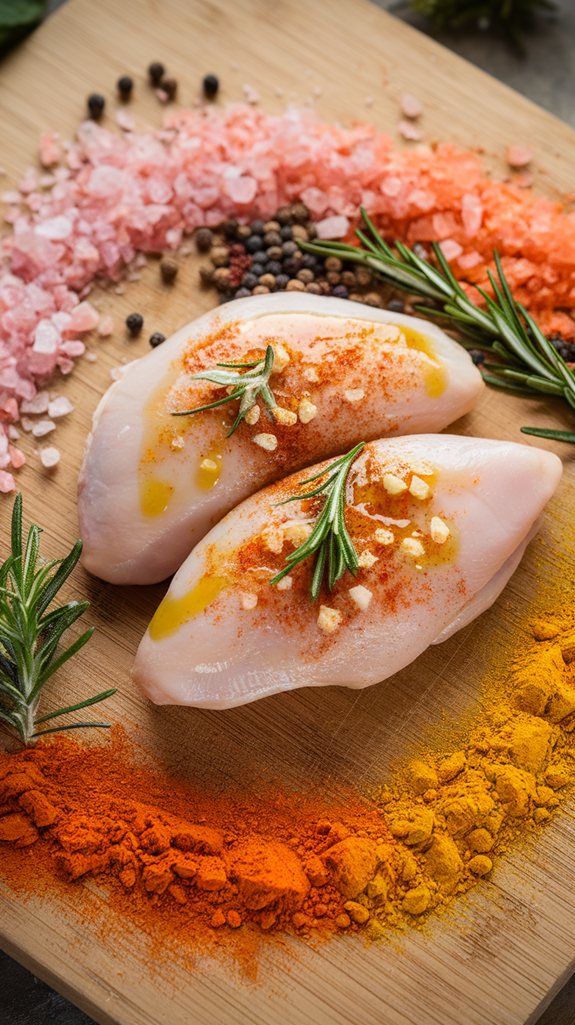
Seasoning chicken is a culinary skill that requires proper technique and timing. Begin by patting the chicken completely dry with paper towels. Then measure approximately one tablespoon of seasoning per pound of meat.
For ideal flavor penetration, apply salt initially, rubbing it both over and under the skin.
Create depth by layering seasonings strategically – start with base spices like garlic powder and black pepper, follow with aromatic herbs such as thyme or rosemary, and finish with heat elements like paprika or cayenne.
Allow seasoned chicken to rest for 30 minutes at room temperature before cooking, letting the flavors fully develop.
For maximum moisture retention, cook at 325 degrees Fahrenheit to prevent dryness while ensuring even doneness throughout.
Classic Chicken Seasoning Combinations
Classic chicken seasoning combinations is a culinary approach that relies on mastering time-tested flavor blends professional chefs have refined over decades.
The key lies in balancing flavors and understanding how different ingredients interact during cooking.
- Mediterranean blend: 2 tablespoons oregano, 1 tablespoon each of basil and thyme, 3 minced garlic cloves, zest of one lemon
- Southwest mix: 1 tablespoon each of chili powder, cumin, and paprika, plus 2 teaspoons garlic powder
- Asian fusion: 2 tablespoons soy sauce, 1 tablespoon each of ginger and sesame oil, 2 teaspoons rice vinegar
These versatile combinations work similarly well for grilling, roasting, or pan-frying chicken.
From Simple to Complex: Popular Chicken Recipes
Chicken recipes are fundamental in understanding how to progress from basic to advanced cooking techniques. From a simple seasoned baked chicken breast to the rich, aromatic flavors of tandoori chicken, each recipe builds upon core seasoning principles.
| Recipe | Difficulty | Key Seasonings |
|---|---|---|
| Baked Breast | Easy | Paprika, garlic powder |
| BBQ Rub | Medium | Brown sugar, smoked paprika |
| Tandoori | Complex | Garam masala, yogurt marinade |
Experimentation with different recipes reveals how seasonings interact and develop, creating depth through layered flavors, cooking methods, and precise timing. Similar to pork chops, proper chicken preparation requires meat temperature control to ensure juicy, tender results.
Tips and Techniques for Maximum Flavor
Maximum flavor is achieved through careful layering of ingredients and proper timing of their application. The process requires attention to both technique and timing, with each step building upon the last to create depth of flavor.
- Start with a dry brine using 1 tablespoon kosher salt per pound, allowing 30 minutes for absorption.
- Apply oil-based seasonings, using 2 teaspoons of spices per pound of meat.
- Finish with fresh herbs and acids in the last 5-10 minutes of cooking.
Every layer contributes distinct elements, from the foundational saltiness to the bright finishing notes of fresh herbs and citrus, creating a harmonious blend of flavors. Following Gordon Ramsay's technique, seasoning should be adjusted throughout the cooking process for optimal results.
Best Practices for Different Cooking Methods
Cooking methods is a key factor in determining the right seasoning approach for chicken.
For grilling, a robust dry rub with 2 tablespoons of seasoning per pound works best when applied 30 minutes before cooking.
Baking benefits from a lighter touch of just 1 tablespoon per pound.
Pan-frying calls for seasonings that can withstand high heat without burning, particularly herbs like thyme and rosemary.
Slow-cooking methods allow for more delicate spices and fresh herbs, as the extended cooking time helps flavors develop gradually.
For best results, marinated chicken needs 4-24 hours of refrigeration before cooking.
